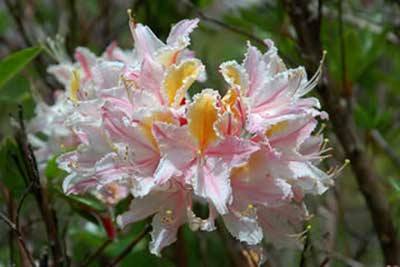Western Azalea
- Scientific Name: Rhododendron occidental
- Garden: Wildlife Garden
- Plant Type: Shrub
- Evergreen/Deciduous: Deciduous
- Sun/Shade Exposure: Full Sun or Part Shade
- Moisture Requirements: Moist, Well-Drained
Plant Information
Native to Oregon and California coastal areas – Flower color varies on plants found in the wild, or in plants grown from seeds. White, pale pink, yellow to orange or combinations of all of these colors are common. Flowers have a sweet honeysuckle-like scent and bloom in mid-April to early May. Leaves are green and turn yellow, orange and red in fall. Growth is more compact than many other deciduous Azaleas, to about 3-5’ with a denser shape. Hardy to -5f. Culture: Unlike their evergreen relatives, deciduous Azaleas and Rhododendrons thrive in full sun. Part-shade to shade is fine too. Plants grown in more shade will have an open airy shape and fewer flowers than plants grown with more light. Any Rhododendron or Azalea prefers well-drained soil with an acidic pH. The Pacific Northwest naturally has soil with low pH because of copious rain, but much of the area has heavy clay soil, so mixing compost to the bed before planting is advised. Rhodies and Azaleas have shallow root systems and prefer a thin layer of mulch, under 1". Fertilizer used should be specific to acid-loving plants, and directions should be followed carefully. Problems: Enemy number one used to be powdery mildew, but now Portland has a pest called Azalea Lace Bug, which sucks chlorophyll from the inside of the foliage, leaving white or coppery stippling.
Data Source
https://www.portlandnursery.comPlant Photos









